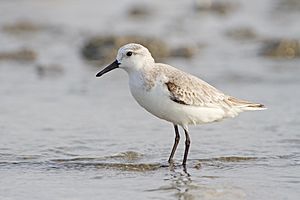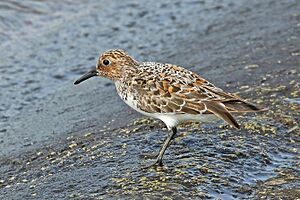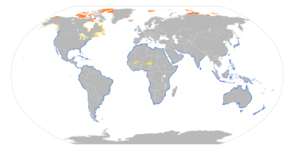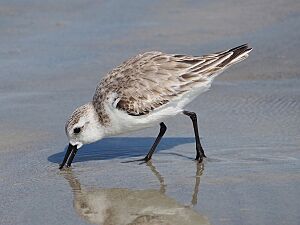Sanderling facts for kids
Quick facts for kids Sanderling |
|
|---|---|
 |
|
| Non-breeding plumage, Laem Phak Bia, Phetchaburi, Thailand | |
 |
|
| Breeding plumage, Farmoor Reservoir, Oxfordshire | |
| Conservation status | |
| Scientific classification | |
| Genus: |
Calidris
|
| Species: |
alba
|
 |
|
| Sanderling range. | |
| Synonyms | |
|
|
The sanderling (Calidris alba) is a small bird that loves to wade in water. Its name comes from old English words meaning "sand-ploughman," because it digs in the sand. The scientific name Calidris alba means "white waterside bird."
These birds breed in the cold Arctic regions all around the North Pole. They are amazing long-distance travelers, flying south for winter to places like South America, Europe, Africa, and Australia. In winter, they often gather in large groups on sandy beaches or muddy shores.
Sanderlings look a bit different from other sandpipers. They are about the same size as a dunlin, but they are a bit plumper with a thicker beak. When they fly, you can see a bright white stripe on their wings. They run along sandy beaches very quickly, like they are "bicycling" with their legs. They often stop to grab small food items.
They mostly eat small crabs and other tiny creatures without backbones. In spring, when they fly north from South America, they eat many horseshoe crab eggs in the Delaware Bay area. When they reach their Arctic breeding grounds, they lay 3 to 4 eggs right on the ground. There, they mostly eat insects and some plants.
The sanderling was first described by a German scientist named Peter Simon Pallas in 1764. Sanderlings are protected by an agreement that helps save birds that migrate across Africa and Eurasia.
Contents
What Does a Sanderling Look Like?
The sanderling is a small, round bird, about 18 to 20 centimeters (7 to 8 inches) long. It weighs between 40 and 100 grams (1.4 to 3.5 ounces).
In winter, the bird is very pale, almost completely white. It only has a dark patch on its shoulder. This white color is why it's called alba, which means "white" in Latin. Later in the summer, its face and throat turn a reddish-brown color. Young sanderlings are black and white with many spots. They look much more colorful than the adult birds.
It can be tricky to tell a sanderling apart from other small wading birds. But if you look closely, you'll see that sanderlings do not have a back toe. Their special way of running and feeding also helps you identify them.
Where Do Sanderlings Live and Travel?
Sanderlings breed in the very cold High Arctic parts of North America, Europe, and Asia. In North America, they breed in places like the Canadian Arctic Archipelago, Nunavut, and Greenland. In Europe and Asia, they breed in Spitsbergen and parts of northern Russia.
During the northern winter, you can find sanderlings on almost all the world's coasts. They are true long-distance travelers, flying between 3,000 to 10,000 kilometers (1,800 to 6,200 miles) from their breeding areas to their winter homes. Birds that fly farther also arrive later and leave earlier. Most adult birds leave the breeding grounds in July and early August. Younger birds leave later, in late August and early September. Their journey north begins in March.
Sanderlings choose to breed in dry, rocky areas near wet spots in the tundra. These areas are usually between 60 meters (200 feet) and 800 meters (2,600 feet) above sea level. In winter and during their travels, they are most often found on sandy beaches. But you might also see them on sandy or muddy areas exposed at low tide, or along the shores of lakes and rivers. Sometimes, they even visit rocky shores.
Sanderling Types
There are two main types of sanderlings:
- C. a. alba: This type breeds on Ellesmere Island, northern and eastern Greenland, Svalbard, Franz Josef Land, and the Taymyr Peninsula.
- C. a. rubida: This type breeds in northeast Siberia, Alaska, and northern Canada.
How Do Sanderlings Behave?
How Sanderlings Find Food
Sanderlings look for food by digging in the sand in the upper part of the beach where the waves come in. They mostly eat small creatures like isopods and mole crabs. When the tide is out, these creatures hide deep in the sand. But when the tide comes in, they move closer to the surface to eat tiny bits of food that wash over them with each wave. Then they quickly dig back down as the water goes out.
Sanderlings don't see these hidden creatures. Instead, they poke their beaks into the sand randomly to find them. Their beaks can only go about 2 to 3 centimeters (1 inch) deep. As the water moves around and pulls back, the sand becomes softer. This makes it easier for the birds to push their beaks deeper. It looks like the birds are running wildly at the edge of the waves. But they are actually trying to catch as many prey animals as possible when they are easiest to find near the surface.
Sanderling Breeding and Family Life
When it's time to breed, sanderlings become very protective of their space. The male bird will bravely defend its territory. They might form pairs where one male and one female stay together. Or, sometimes, one female might have two male partners.
Images for kids
-
Sanderling at High Island, Texas
-
A Sanderling in Cagayan de Oro, Philippines
-
A flock displaying their distinctive behavior of running with the ebb and flow of waves (while feeding). Willapa Bay, near Tokeland, Washington.
-
Resting at the Monterey Bay Aquarium aviary.
-
Sanderlings feeding in Quogue, New York














